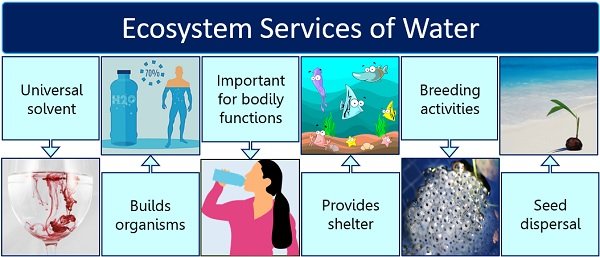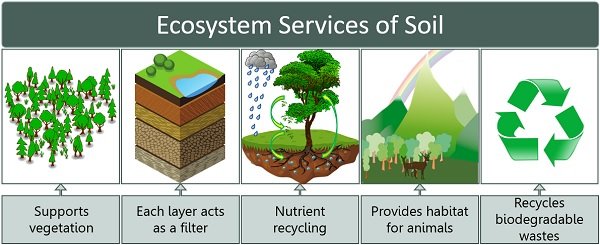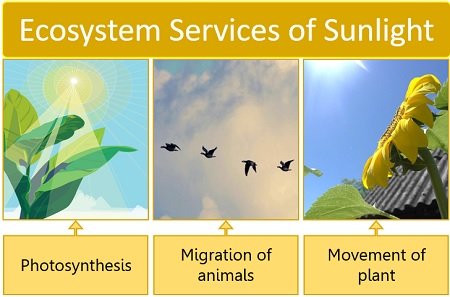Abiotic factors are the ones with the non-living origin but have a major influence on the living organisms associated with the ecosystem. These include physical components like air, water, light, soil, temperature etc.
We can define the term abiotic by breaking it into ‘A‘ (means without) and ‘Biotic‘ (means life). Abiotic factors can be physical or chemical factors that are lifeless or inanimate.
Our ecosystem is a unique entity where abiotic and biotic factors form a bubble of life. Both the factors are closely related to each other through nutrient cycles and energy flows.
The ecosystem serves a variety of goods to the producers and consumers. This post describes the definition of abiotic factors and their types and ecosystem services.
Content: Abiotic Factors of Ecosystem
Definition of Abiotic Factors
Abiotic components greatly influence the reproduction, growth and maintenance of the living organisms residing in the particular ecosystem. They are equally important as the biotic or living components to maintain the balance in the ecosystem.
The three major categories of abiotic factors include:
- Climatic factors like temperature, humidity and sunlight.
- Edaphic factors include soil and geographical conditions.
- Social factors involve the consumption of land and water resources.
Let us discuss how the abiotic components influence the biotic components?
Desert-adapted snakes need an arid climate and loose soil to survive. But what if someone picks up one of the desert-adapted snakes in the Himalayas? In this case, the snake will not be able to survive because they are adapted to the live desert conditions.
The arid climate and loose soil are the abiotic factors necessary for the survival of desert-adapted snakes. But, if we shift the desert-adapted snakes to a snowy peak in the Himalayas, they will not be able to survive.
Types of Abiotic Factors
Abiotic factors are non-living parts of the ecosystem that influence the growth and activity of living organisms. The most important abiotic factors include:
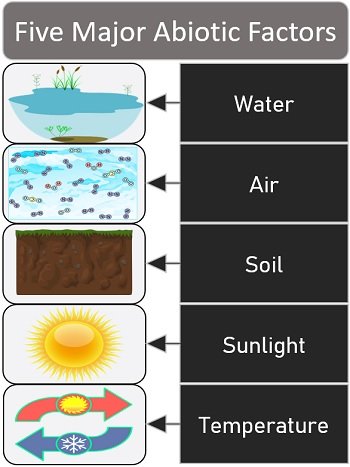
Water
Its chemical formula is (H2O). The life of all living organisms depends upon water. We generally feel thirsty when we take a long run. It is due to your body signalling to you that you need water.
Water links all ecosystems on the planet. It is replenished through the hydrological cycle. On earth, oceans contain most of the planet’s water. But, air helps to move water into ice and vapour states.
The heat produced by the sun evaporates the surface water into water vapours. Then, the water vapours reach a level in the atmosphere, where the temperature falls. Later, they condense into clouds.
When the precipitation within clouds increases, water vapours in the cloud turn into large water droplets. Eventually, clouds return water to the ground in the form of rain, snow or sleet. This process replenishes different waterways.
Is water abiotic or biotic?
Water is an important abiotic factor that makes up 50% to 70% of living organisms. It falls as rain and snow over the land and covers 71% of the earth’s surface.
Depending upon the water level, organisms can live in an environment in two possible ways:
- Only organisms with no or little water requirements can survive in an environment with little water.
- On the other hand, marine animals and underwater plants thrive in the ecosystem with large amounts of water.
The amount of water in the particular habitat decides the type of organisms adapted to that environment. For example, desert animals live in a scarcity of water and are adapted to less vegetation.
Ecosystem Services
Water has manifold applications in the ecosystem; some of them are mentioned hereunder:
- Water is necessary because the body of all living organisms has an adequate amount of water.
- Processes like seed-germination, nutrient absorption, food assimilation, digestion, excretion, and many more need the presence of water. All these chemical reactions need water as the medium.
- Water helps in the distribution of plant species, as it is one of the mediums of seed dispersal.
- It provides habitats for the organisms adapted to live in the aquatic environment.
- Water provides temporary space for the breeding of various amphibians, insects etc.
- Water acts as a universal solvent in which gases like oxygen and carbon dioxide easily dissolve. It contains dissolved salts and minerals that plants and animals can utilize to survive.
Soil
Soil is an important abiotic factor. It consists of rocks and decomposed matter of plants and animals. The soil has different types with different functions, based on its composition. For this reason, a group of plants and animals live in a specific area.
The soil texture and composition determine the amount of water the soil can hold. The water in the soil nourishes crops and keeps the soil’s organic matter alive. Plants intake water and minerals from the soil via tiny root hairs.
Then soil porosity is another crucial factor that decides the amount of oxygen and water retained in soil pore spaces. This factor is essential for the conduction of air, water and nutrients to the plants.
Thus, plants depend on soil for many of their growth requirements. Soil is a prominent abiotic factor that supplies all the mineral nutrients needed for plant growth.
A soil rhizosphere is a zone lying next to the plant’s root where a unique population of microorganisms inhabit by promoting plant growth.
Humus of soil contains dead or decayed remains of plants and animals, making the soil fertile. Fertile soil is rich in nutrients sustainable for plant growth. Fertile soils contribute to food security, good yields for farmers and economic development.
Ecosystem Services
- Soil provides an open habitat for various plants and microorganisms by nurturing them with essential minerals and nutrients.
- It helps in carbon and nutrient recycling.
- Soil particles filter the running surface water into the groundwater.
- Soils are the stomachs digesting all the recyclable wastes in the environment.
Air
Life on earth is impossible without air because everyone needs air to breathe. Air is a mixture of gases, namely nitrogen 78 % and oxygen 21 %. It also contains small concentration of carbon dioxide (0.03) %, argon (0.3) %, water vapour and dust particles. Below, we will discuss the ecosystem services of air.
Air and the Carbon Cycle
Air also helps in the recycling of carbon. The burning of fossil fuels, respiration, and decomposition of organic matter are the sources of carbon.
During respiration, animals and humans expel carbon dioxide into the air. Plants use the carbon dioxide in the atmosphere to sustain life during photosynthesis. As a result, oxygen is released as a by-product by the plants, which we use to respire.
Animals eating plant-based foods ingest carbon and produce the energy they need to live. At last, the carbon returns to the atmosphere by the death of decomposition of organic bodies.
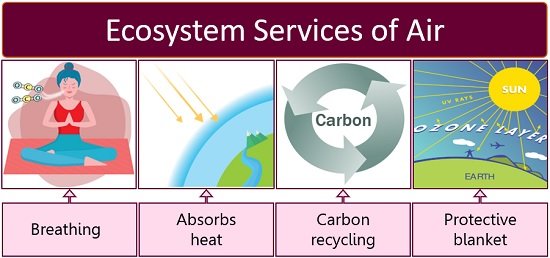
Air to breath
Animals, birds and humans take oxygen from the atmosphere and use it to oxidise food into energy and heat. In addition, all living organisms need oxygen for respiration. Oxygen is also used during combustion (burning).
Air as Protective Blanket
Earth traps more heat in the atmosphere when there is too much concentration of greenhouse gases. A high concentration of greenhouse gases in the atmosphere leads to global warming.
The stratosphere in the earth’s atmosphere protects humans and other animals susceptible to harmful UV radiations.
Exposure to UV rays on the skin can cause genetic changes and the growth of cancerous cells. The ozone layer in the stratosphere acts like a shield that protects the creatures on earth.
In the environment, the soil microorganisms convert nitrates in the soil into atmospheric nitrogen. Plants absorb nitrogen to make proteins that the plant cells need to grow. Low nitrogen availability leads to low crop yields. However, high nitrogen content can be toxic to the plants and the environment.
Sunlight
It is a critical abiotic factor as it acts as an ultimate energy source. We get light and heat from the sun. We also know that plants need sunlight to undergo photosynthesis, where they use carbon dioxide and water to make oxygen and food.
In our ecosystem, plants act as primary producers that serve food for many organisms like herbivores (cows, goats etc.). And the oxygen they supply is necessary for the organisms to breathe or respire.
Thus, green plants can turn captured solar energy into chemical energy. Other living organisms consume the stored chemical energy in the food prepared by the plants through the food chain in nature.
So, there is nothing wrong with saying that plants could not live without the sun. Likewise, animals and humans could not live without plants!
Ecosystem Services
- Light also determines the migratory activities of animals like fishes, birds, mammals, reptiles etc.
- The presence of light influences the activities of plants and animals in various ways.
- Light triggers the opening and closing of the stomata, seed germination, flowering and movement of plants.
- Then, the light also directs the movement, sleeping and feeding activities of animals. The presence of sunlight activates gonads and annual breeding activities in birds.
- Sunlight can affect the behaviour of certain animals. Most animals that are active under bright light or during the daytime are called diurnal animals. Whereas some animals like owls, bats, and earthworms that are active during the nighttime are called nocturnal animals.
Temperature
Sunlight is the factor regulating the impact of temperature on the earth. The strength of sunlight varies by location, which means the temperature zone is different in various parts of the earth.
Tropical, subtropical, temperate and alpine zones are the temperature zones of the earth. Any increase or decrease in the strength of sunlight alters the intensity of temperatures in different zones.
All living organisms have a level of tolerance for the range of temperature. The majority of organisms cannot withstand temperatures below 0 °C or above 45 °C. Organisms living outside this range must develop physiological and behavioural adaptations to withstand extreme temperatures.
For example, a penguin from the polar region couldn’t live in desert climatic conditions. The climate would be too hot for them to survive because the polar bear’s body is adapted to live in the cold environment. Their thick layers of fat and fur insulate the body against cold.
Thus, the temperature in a particular region decides which plants and animals can live in that area. The air and water temperature affect the distribution of plants, birds, animals, and humans in nature.
Animal adaptations for winter
Some organisms develop resistance to cope with the extreme cold in winters. While some migrate to different habitats. Some hibernate themselves or undergo winter sleep.
- Organisms living in polar regions are already adapted to survive the extreme cold. They have a thick layer of feathers and hair and large fat deposition on their body. Their greasy coat helps to reduce heat loss.
- Then, birds, fishes and reindeer go through winter sleep in warmer areas.
- Migration is the third strategy, in which a group of animals migrate from one location to the other.
Animal adaptations for summer
Mobile organisms like frogs, insects, reptiles and mammals in hot springs undergo aestivation. Snakes, frogs, etc., reside in the burrows for most of the day or they sleep in the dark and shady areas. So, these organisms become active when the temperature falls.
- Bats, owls, cockroaches etc., are the nocturnal animals active during the night.
- Balbacus, bobcats, bats etc., are auroral animals primarily active during the dawn or twilight.
- Flies, moths, some bats and owls are vespertine animals active at dusk.
Plants adjust to variations in the temperature by adapting themselves to cold or hot conditions. They have thick cuticles and bark. Some plants have thick leaves and hairs. They have chemicals like mucin and tannins that provide resistance against pathogens.
Depending on the temperature, microorganisms are classified as psychrophiles, mesophiles, thermophiles, thermotolerant, and extremophiles. The temperature determines the rate of metabolic reactions.
It also affects various enzyme-catalysed reactions. At higher temperatures, enzymes denature, but some enzymes are thermostable. For example, Taq polymerase isolated from the bacterium (Thermus aquaticus) withstands higher temperatures.
Conclusion
Therefore, we can conclude that abiotic factors are the non-living factors influencing the living components of an ecosystem.
